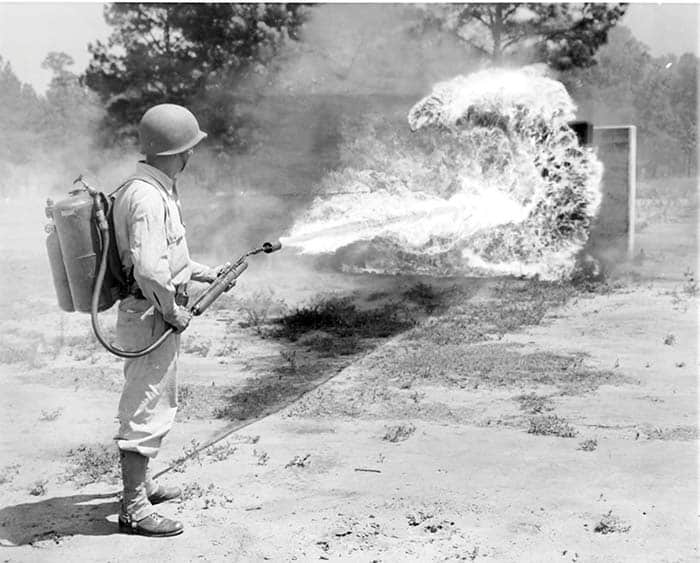Test firing E1R1 at Ft Benning 1941. The E1R1 is easily identified by the shorter pressure bottle and the fuel valve on top of the fuel tanks. The later standardized M1 had a pressure bottle the same length as the fuel tanks and a fuel valve on the right side of the tanks so the operator could turn on the fuel.
By Charlie Hobson
I was impressed with the accuracy and completeness of Robert Bruce’s “Current Status of Flamethrowers” in the October issue of SAR. I wasn’t surprised when I was contacted to present additional articles on the development and usage on both of the World War II flamethrowers, the M1 and the M2-2. The two models are diametrically very different, the M1 was a “Ninety Day Wonder” by a fire extinguisher company that had a multitude of problems, but the M2 was the culmination of extensive development efforts by the National Defense Resource Council, universities, manufactures and research think tanks. The totally unique M2-2 was very successful and a dozen or more are still working today. I don’t hesitate to say that the M1 was the worst flamethrower of any army but the M2 was the best and most successful flamethrower of WWII.

Development of the M1
The story of the first standardized US military flamethrower really begins with the US Armed Forces in WWI arriving on the French front in 1917. Germany had already developed five models for use with Blitzkrieg attacks by shock troops. French and English troops captured most models, copied the most useful and then used them successfully to break the trench stalemates. When the US tried to develop a flamethrower less than a year before the war ended, we had only one prototype model which was heavy and never tested in combat. All of the US examples were destroyed 1922 and all flamethrower development stopped until July 1940.
Strangely, between World War I and II, the Chemical Warfare Department denied that flamethrowers were effective and did not attempt to develop them. In fact the Chief of the CWS instructed personnel not to mention these unless asked and he also publicly stated that “flamethrowers did not work because of short range and you could simply duck under the flames”. Many Axis and Allied officers from WWI wrote him that this was not true and even supplied written proof that shock troops with flamethrowers had many successful attacks.
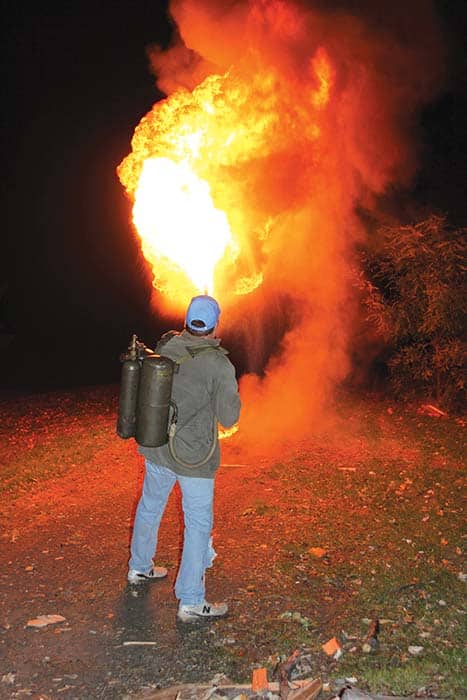
When WWII began in Europe, accounts of German and Italian flamethrowers began to come to the attention of US military personnel. In August 1940 the Secretary of War was convinced that there would be a need for flamethrowers and requested the Chemical Warfare Service to begin development. CWS put out the request for construction of a flamethrower with no specifications or guidelines and a deadline of 90 days. Only one company responded, The Kincaid Fire Extinguisher Company of Brooklyn, NY. This was the birth of the term “90 Day Wonder” which came to denote something slammed together quickly and not quite up to par.
In October 1940 the CWS received three E1 prototypes which they sent to the Engineer Test Board for evaluation. The Board rejected this first prototype as: “too heavy, ungainly, and lost pressure too quickly”. As CWS had no design criteria for flamethrowers, the E1 tanks were simply a two segmented tank (one for a compressed propellant gas and one for fuel) and a wand made up from a laboratory hydrogen tank with a battery powered model airplane ignition on a steel barrel with a lever gate valve. The gun was simply an assembly of parts “off the shelf”.
CWS retained the wand design but decided to simplify the fuel assembly using two tanks for fuel, a pressure bottle and a regulator to maintain constant pressure. They forwarded the recommendation back to Kincaid who agreed on the improvements. Kincaid welded two thin walled fire extinguishers together, clamped on a small pressure bottle with a welding regulator and used standard plumbing pipes and valves for the tank assembly. The new designation was the M1R1.
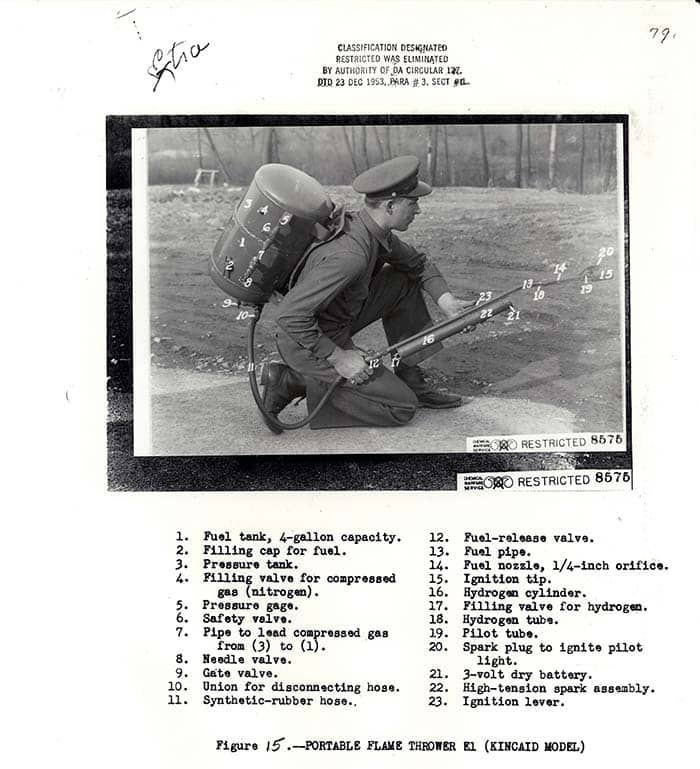
Kincaid presented the E1R1 in March 1941 and it was tested by both the Engineer Board and The Chief of Infantry. They quickly found that that gasoline burned way too fast, that the E1R1 had leaky valves and that connections wore out very fast. Both testing arms requested E1R1 flamethrowers with specific improvements. It is important to understand that virtually no one in the USA knew anything about flamethrowers, which meant the E1R1 was built with plumbing valves for low pressure water at 150 psi which were not compatible with petroleum fuels. In August 1941 the prototype E1R1 was accepted and standardized as the M1 with contracts let in April 1942 to Beattie Manufacturing and in July 1943 to EC Brown. Combined they would make 14,000 before converting production to the M2-2 later in the war.
The Japanese bombed Pearl Harbor on 7 December 1941 and the War in the Pacific began. In February 1942 the Japanese Army used flamethrowers against US forces on Baatan and in response US Chemical Warfare Service officers quickly requested flamethrowers. Flamethrowers did not come in time and it would be December 1942 before the first flamethrowers were use in combat on Buna Village, New Guinea. Because of rust, deterioration and the lack of knowledge to service them, they failed to light and only threw fuel a few feet. They were sadly ineffective. Manufacturing was plagued with multiple problems: parts needed to be shipped thousands of miles, responsibility was fragmented between Engineers, Infantry, Marines and CWS, the constant humidity shorted ignition and metal parts rusted causing pinhole leaks in tanks. The odds were terribly stacked against the USGI M1 flamethrower. But the intense need for a dependable US flamethrower against entrenched Japanese soldiers soon become apparent.
In August 1942 the Marines began the offensive on Guadalcanal where they encountered underground mutually connected fortification which they named “Spider Trenches”. The Japanese used a series of fortifications that were well camouflaged and mutually supported. They were difficult to eliminate because there was no way to flank and direct assaults were costly in lives. The need to burn off cover and to destroy personnel underground was desperately needed. By December 1942, CWS officers were training combat flamethrower operators on the effective tactics of flamethrowers. The first success came on 15 January 1943, when a Marine rifle squad with two flamethrower operators killed five Japanese in one Spider Trench. Two died after leaving the fortification and running a short distance, both of these Japanese soldiers had no burns, no wounds and no plausible reason to die. It would be until just before the end of the war before CWS understood that flamethrowers kill by asphyxiation and carbon monoxide poisoning. Flamethrowers literally shoot around corners and down into underground bunkers. The Marines went on to neutralize two more positions in twenty minutes. On the same day Army Infantry was not successful in any attacks, because they did not have properly serviced flamethrowers and they did not know how to act as a team to protect the operator and coordinated their attacks.
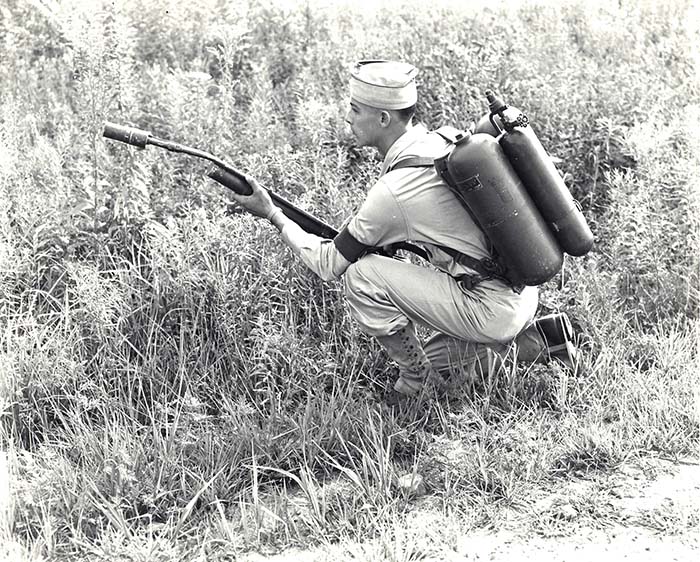
In some cases advance or neutralization took days and up to a week. As accounts of flamethrower successes at Guadalcanal and New Georgia circulated between the Army, Marines and Americal Division (National Guard), each service began their own training programs which led to even more successful assaults. Service groups in Australia, Pacific combat theaters, and at the CWS at Edgewood Arsenal, MD, also worked on making the M1 more reliable, fire greater distances and easier to manufacture. In August 1943 an upgraded model the M1A1 began to arrive in the Pacific theater. It was reliable enough that the requests for more flamethrowers far exceeded supply until the beginning of 1944. However the supply of repair parts and accessories never met demand before The War in the Pacific ended.
As The War in the Pacific progressed, the M1 Flamethrower became the weapon of choice against the tenacious Japanese soldier who was not afraid of dying but would run from flames. The flamethrower continued to be plagued by problems of service, supply of parts and humidity, but as skill with unified teams increased so did successes.
Problems in Combat
To understand the operation and service of the M1, I have restored four to working condition. Through repeated firings, some under simulated combat, I was able to understand the service problems related to the M1’s unrefined design. After years of firing I have experienced all of the reported problems and a few new ones.
The production pressure bottles had valves that leaked so that often times you could only fire a squirt a few feet. The regulator was simply a diaphragm type that has vents and was susceptible to moisture. Valves connecting the fuel tanks and hoses also tended to leak or not shut off completely. Hydrogen bottles for ignition often leaked and when received for combat were empty. The battery, coil and spark plug ignition systems were all prone to shorting and very sensitive to moisture. Even when the M1 was serviced the day before and the weather was sunny and perfect, the M1 would fail to light for no apparent reason.

Mechanical issues are number one but the second group of problems with the M1 flamethrower deal with the operator being very vulnerable because he is easy to see, armed only with a short range weapon and heavily burdened by the heavy flamethrower. Primary importance is that the flamethrower operator must work in conjunction with a well trained assault squad who protects the operator so that is kept out of the action until the target is defined and weapons can be deployed to protect his advance. Riflemen and heavy weapons must keep the enemy down to prevent the flamethrower operator from becoming a casualty.
I have been fortunate enough to work with Marines that still practice historical reenactments of flamethrower assaults. The Living History Detachment of the Parris Island Historical and Museum Society at the MAAM WWII Weekend in Reading, PA. recreates two Japanese firing positions and attacks them with two flamethrowers. From years of regular firings they have learned how to coordinate covering rifle fire, flamethrowers and demolitions. The demonstrations are given three times per weekend during the MAAM WWII Airshow weekend in June.
The flamethrower is a highly effective weapon for aggressive assaults on well camouflaged and underground positions. The Japanese learned early in WWII to dig underground with tunnels out to hidden firing places. The flamethrower is the only weapon that will kill by carbon monoxide poisoning no matter how deep the position. On Iwo Jima, a flamethrower using one shot killed 72 Japanese in one cave. Demolitions were used immediately afterwards to seal the position so that the Japanese could not reoccupy at a later date. Flamethrower assault teams would never use a single flamethrower but rather two or more, as the first flamethrower could burn off the vegetation hiding the enemy firing positions and also create a screen for the second flamethrower to move closer.
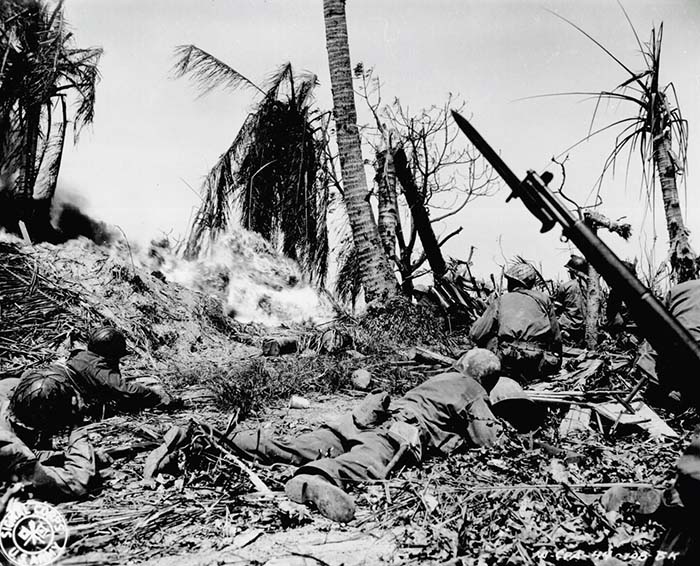
When the Marines went on the offensive in 1943 and 1944 they developed methods to service and waterproof the M1 and the tactics for a flamethrower based assault squad. The numbers varied but the ideal 36 man team was 30 riflemen, bazooka, two flamethrowers with four operators and demolitions for sealing up the underground positions. By the time we invaded Iwo Jima in Feb 1945, over 75% of our ground forces were flamethrower assault teams. Even though the M2-2 was becoming available by the end of 1944, the M1 was in service up until the end of the war.
The Chemical Warfare Service had flamethrowers from other countries early in the war and they incorporated the advantages of each into the next model US Portable Flamethrower. All of the shortcomings of the M1, the fact that Germany and Great Britain had converted from gas and spark to pyrotechnic chare ignition, and the fact the thickened fuel (Napalm) would triple the range of flamethrowers, all contributed to the downfall of the M1. Clearly a completely new model flamethrower was needed and development on the M2 began almost as soon as the M1 was tested in combat.
Author’s Bio
Mr. Hobson has been restoring and writing about flamethrowers for 21 years. He first restored and fired a flamethrower for a museum in 1993 and continues to be the only person authorized by the military museum system to test and rebuild flamethrowers for public firings. He developed the “Safety Rules for Flamethrowers” and has trained hundreds of operators in the operation of flamethrowers. In 2010 he published “The Illustrated Manual of US Portable Flamethrowers” with full color photos of all prototypes and models of USGI flamethrowers. He has been on numerous TV shows firing flamethrowers. He lives in a country home outside Binghamton, NY where he writes, collects, restores and fires flamethrowers.
| This article first appeared in Small Arms Review V20N4 (May 2016) |



